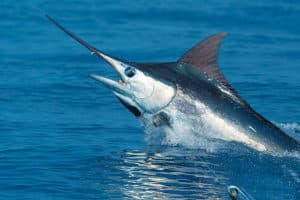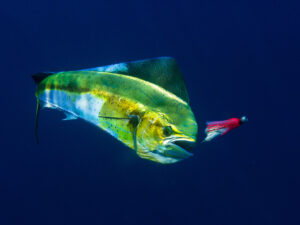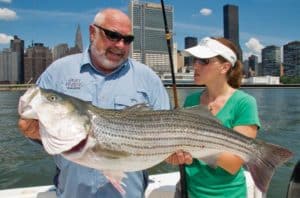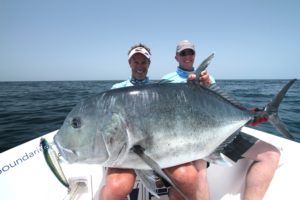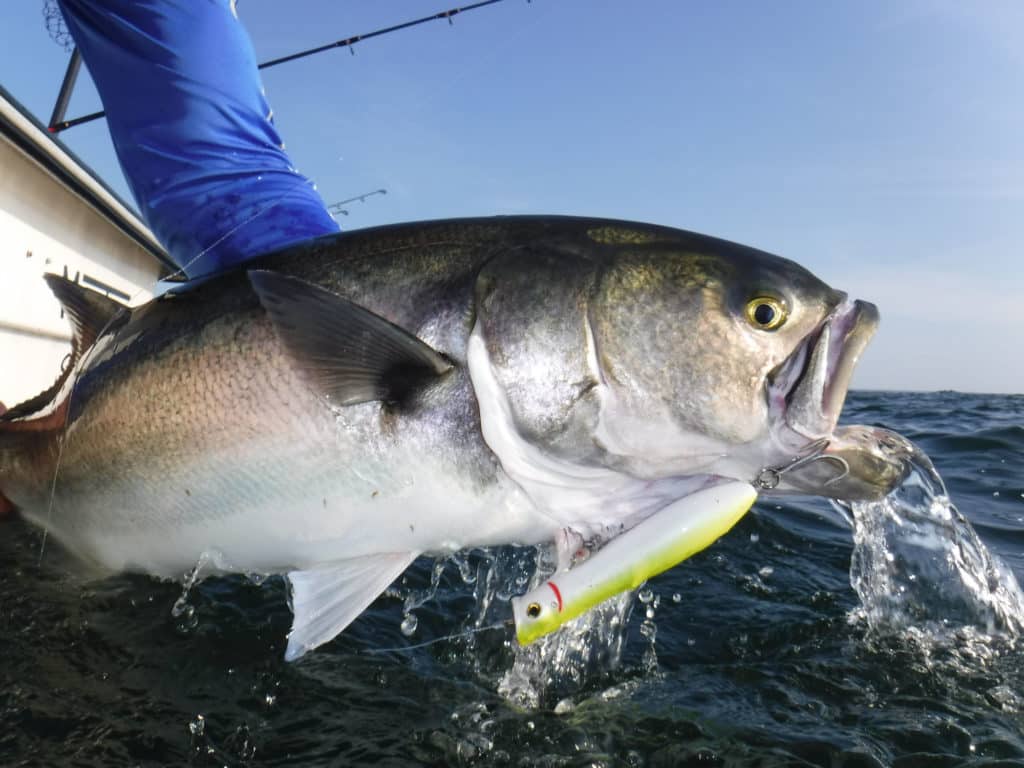
One day early last summer, Elliott Taylor sent me a report saying adult menhaden had just moved into the lower Connecticut River. We knew what that meant—enormous, voracious bluefish must follow.
Later that afternoon, Taylor and I launched in the river at Old Saybrook and motored south toward Long Island Sound, where we soon spotted large baitfish schools swimming nervously inside the breakwalls. Suddenly, a tell-tale swoosh—like a small wave crashing on a beach—spun our heads in time to witness hundreds of 15-inch menhaden thrashing across the surface, obviously pursued by aggressive predators below.
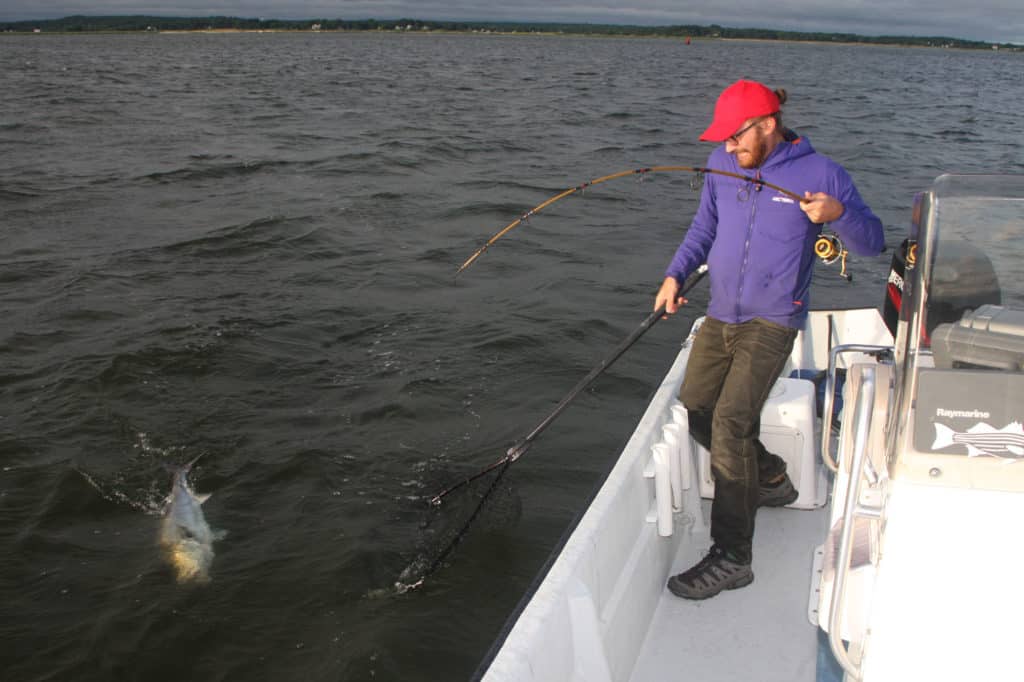
As we coasted into casting range, Taylor zipped out a 5-inch Rapala Skitter Pop, leading the frenzied school like a quarterback uncorking to a favorite receiver downfield. Moments after he started a chugging retrieve, a 17-pound bluefish crashed his plug and ripped out line against a tight drag.
Meanwhile, I cast a spinning outfit, rigged with a 6/0 treble bunker-snag, into the melee, and after just one rod sweep snagged one of the baits. I opened the bail to allow the menhaden to stay with its school. The slow, steady unfurling of line suddenly accelerated into a high-speed spin-off.
With my heart racing to match the line tempo, I counted to five, closed the bail, and leaned back into a fish matching Taylor’s beast. It was an amazing start to a world-class fishing day just a short ride from the launch, and we were the only boat on the action.
Big-Head Phenomenon
Late each spring and into summer, bluefish ranging from approximately 12 to 18 pounds follow warming waters and baitfish into major southern New England estuaries like Long Island Sound. Fresh from their offshore spawn and lengthy migration from over-winter southern waters, these large blues are called “big-heads” or “racers” because they’re lean from their months-long calorie expenditure. They then earn the nickname “slammer” blues later in the summer when they’re fattened for the return migration south.
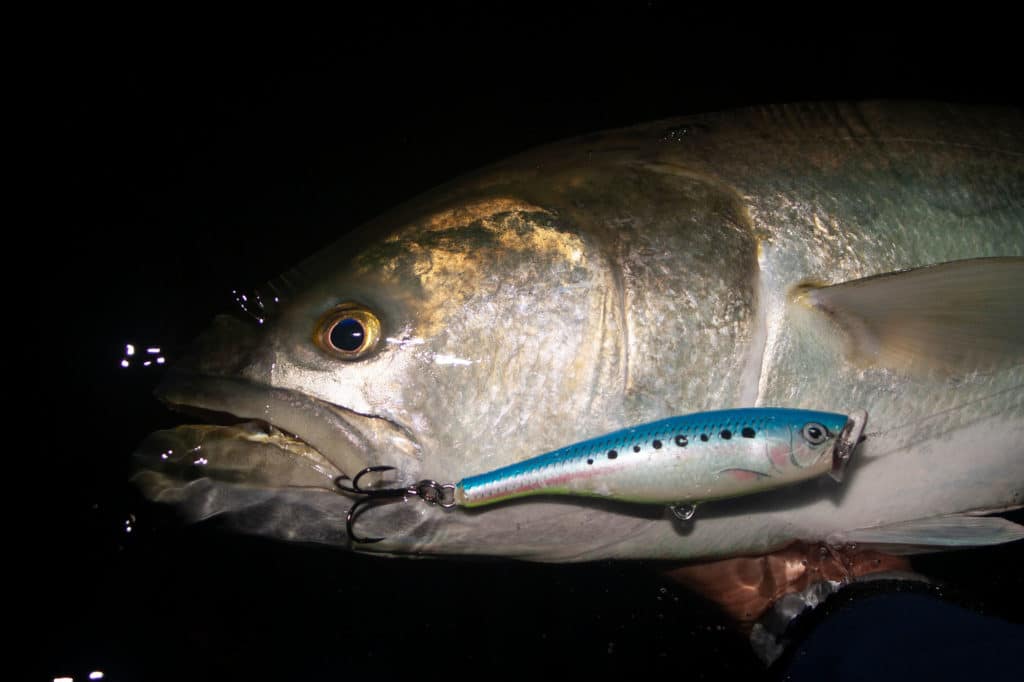
With a predictable annual pattern, big-heads first show in western Long Island Sound in May, where they exhibit strange surface behavior, possibly linked to remnants of their recent spawning ritual. They make fantastic surface sport for dedicated anglers in the know.
Out in the Deep
“Every spring, I consistently have excellent topwater fishing to big bluefish, and I have clients booking a year in advance to get in on this mid-sound deepwater thrill,” says Capt. Chris Elser, a pro with 40 years’ experience. “These blues cruise the surface, making v-wakes, and from a distance you think they’re bunker (menhaden) or small fish, but then you get close enough to take a cast and you’re suddenly into a 15-pound gator blue. Big bluefish are the best topwater sport we have in the sound.”
Finning blues play the fool for topwater plugs, striking out of instinct or aggression rather than feeding, Elser says. “If you’re able to work a lure partly under the surface and partially on top—in the ‘surface film’—it creates a seductive wake that’s not too splashy and very predictable for them to track and ambush, especially when retrieved in a walk-the-dog fashion.”
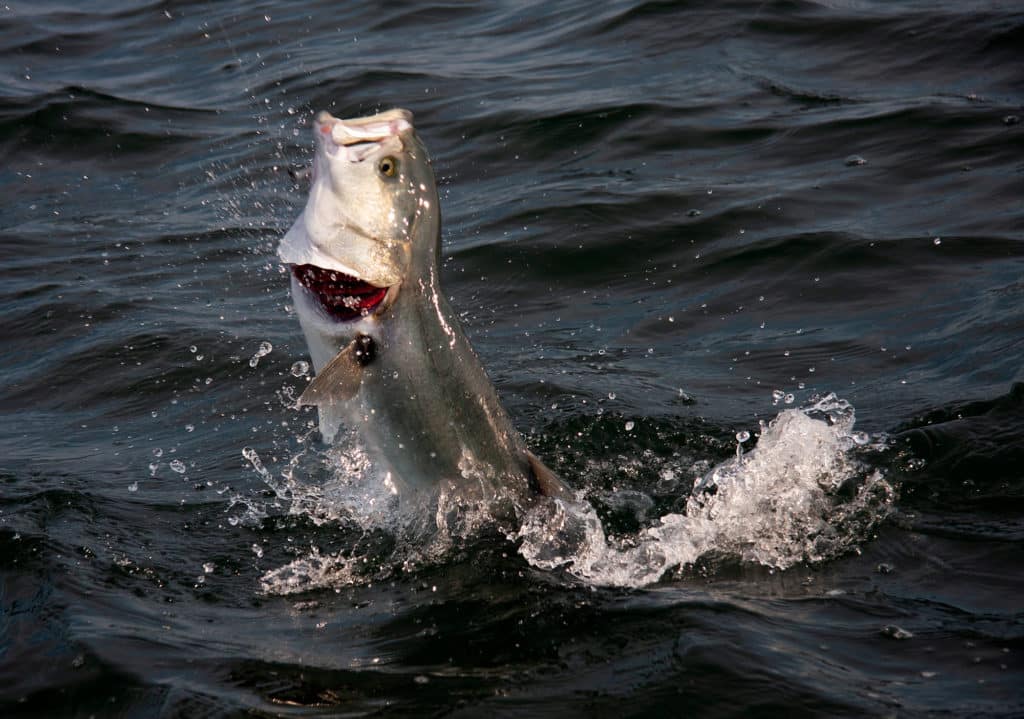
The surface-finning phenomenon occurs in open-water depths of 70 to 100 feet near mid-sound—very uncharacteristic of more typical bluefish staging areas like rips or harbors. To take advantage of this annual event, you need good sun and light winds, conditions that are most prevalent from late morning to early afternoon. “No need to get up early or stay out late,” Elser adds. “This is banker’s hours fishing.
“Such conditions increase your chances of finding and hooking into these surface cruisers because it’s strictly sight-fishing. There’s a lot of open water out there, and if you can’t see them you won’t get the action. Once you locate the blues, you’ll soon find you’re tangling with 30-plus-inch (fork length) fish, with some real trophies of 36-plus-inch fish mixed in.”
The monster blues attack plugs, but Elser’s go-to lures are soft plastics because they create the subtle surface wake necessary to trigger consistent strikes. He favors a 7-inch Big Occhi in white or bone color. Other good options include a 6-inch white Slug-Go or Hogy.
“I prefer the Big Occhi,” explains Elser, “because they’re more durable than other soft plastics, and they perform best for the walk-the-dog retrieve. I’ve tried hard plastics like a Zara Spook and similar lures, and although they draw hits they don’t work as well, possibly because they aren’t directly in the surface film like the Big Occhi rides.
Elser rigs the plastics with a weightless swimbait hook like a 6/0 Owner Beast Hook with twist lock. To the main line he ties a length of 30-pound fluorocarbon leader connected with a double-Albright to 6 inches of 30-pound knottable wire. He ties a non-slip loop knot from the wire to the hook to achieve the proper walk-the-dog action. This configuration works for surface plugs, too.
For an outfit that handles light lures but can also subdue big bluefish, Elser recommends a stout rod like a 7-foot, 10- to 20-pound-class Lamiglas Tri-Flex rigged with a 3000- to 4000-class spinning reel loaded with 20-pound smooth braid.
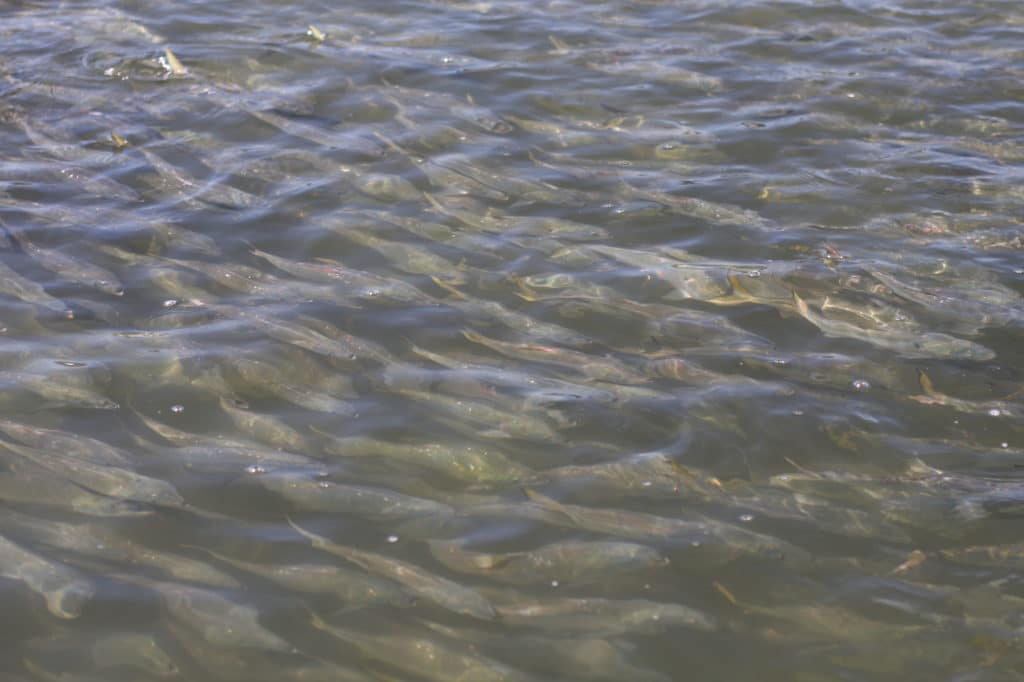
Bunker Dunking
Following May’s mid-Sound finning bite, big-heads move near shore and key on adult bunker schools, gorging on them along the Connecticut coast. Being zooplankton feeders, bunker congregate in the nutrient-dense harbors and estuaries of southern New England as the waters warm. Schools are easy to spot because they ripple the top or fin just beneath the surface in dark, amoeba-like masses. Because they’re filter feeders, however, you can’t catch them conventionally. Snagging bunker simply involves casting a weighted “bunker snag” treble hook across a school and retrieving it with brisk, sweeping rod pulls. It’s important to hold your rod tip low to keep the rig in the water as long as possible, which also helps avoid having the snag rocket into the cockpit.
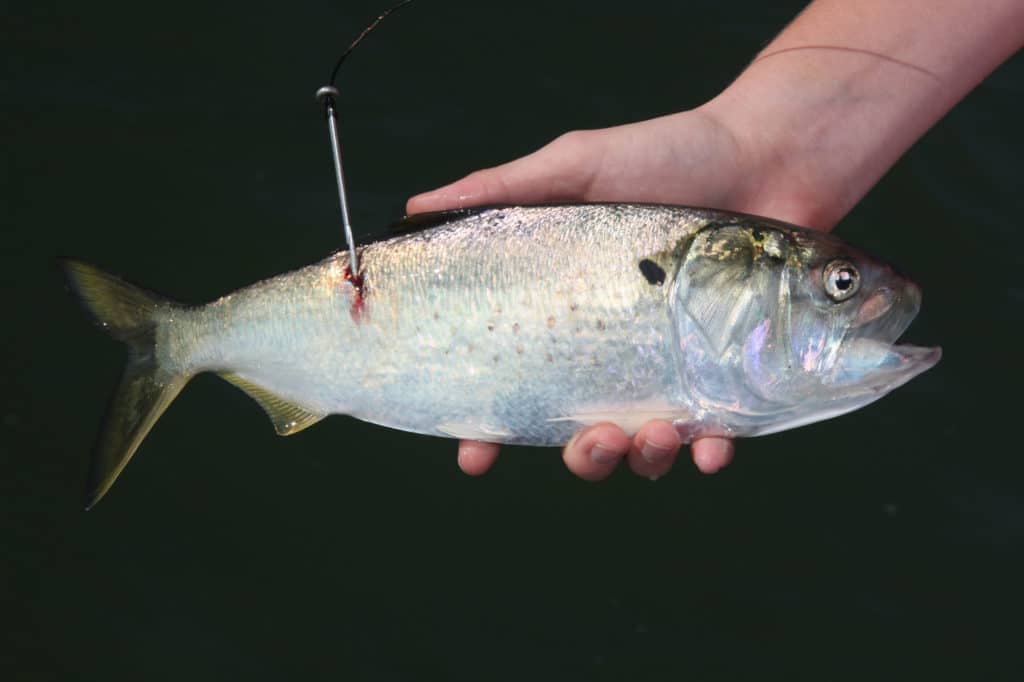
A live-lined bunker appears wounded and swims below and behind the school—the direction predators are coming from—and makes an enticing target. Once a baitfish is swimming, leave your bail open to avoid holding the bait away from the school. When a bluefish grabs your bunker, let it run about five seconds, flip the bail and set the hook as the rod loads. But don’t wait too long because that increases the chance of gut hooking. Some anglers quickly reel in a snagged bunker and re-hook it near the tail using another outfit already rigged with a single 8/0 circle or J hook, and then lob it back into the school. An 8- to 18-inch wire leader is import to prevent cutoffs from razor teeth.
Shallow Stalking
Large bluefish often settle into shallows to stalk random prey when not targeting bunker schools. Such fisheries occur along estuary perimeter waters like the sides of the lower Connecticut River. An expert in gator bluefishing, retired captain Dixon Merkt has 50-plus-years’ experience fishing the river.
“Because these big blues often show no signs in the shallows,” says Merkt, “especially in the murky river water, cover as much ground with your casts as possible. Start reeling before the lure hits the water so the splash and the lure movement are part of the same action. This also eliminates slack line, which allows you to have immediate control of the lure.
“Work the shallows, channel edges and eddies. The best time is on calm days when you can read subtle surface variances. The current lines come and go throughout the tide, so you have to study the surface to find your next opportunity. Unlike sightcasting to specific fish, you never know when or what retrieve will draw a strike, so try your retrieve fast and steady but also slow, twitching, popping, and even stop-and-start. Most important is to set the hook on the feel of the strike not the splash. Without an actual take you’ll pull the lure out of the strike zone and be unable to tease that fish into attacking again.”
Not all depths produce strikes, no matter how fishy an area looks. You must put in your time and learn the spots and nuances of this sport. Bluefish under too much water can’t sense or won’t pursue a topwater lure. If bluefish are present and active, they’ll come up from maybe 15 feet to grab a plug—but not much more. On the shallow end, stealthy pros catch them in as little as 18 inches of water. The action in this range can be phenomenal.
Attach your main line of 20-pound mono or braid to a short leader of 45- to 60-pound flexible, vinyl-coated wire. Avoid single-strand wire because it changes the action of the plug and can kink. Many experts, including myself, simply use 18 inches of 60-pound mono because bluefish strike from behind and rarely reach the leader of a lure, and of course, it’s almost invisible.
For lure choice, Merkt likes the Musky Mania 7-inch Lil’ Doc in bone color fished in walk-the-dog fashion, but he also uses various 5- to 7-inch floating plugs, which draw savage, heart-stopping strikes right up to the boat. He emphasizes that altering these plugs is important for you and for the fish.
“I take all the treble hooks off,” says Merkt, “and put a single 6/0 or 7/0 hook on the back. Or you can take the front treble off and just leave the rear treble in place. I don’t believe we lose any fish as a result. That’s all I fish with. This way you’re able to dislodge the hook without hurting yourself or the fish and can release it with little trauma. Using just one hook goes a long way in promoting conservation.”
Big Rips
The largest of Long Island Sound’s rips—the massive Race and Plum Gut—both of which are tidal entrances in eastern Long Island Sound, can hold big-head blues from late spring into mid-summer, where they fatten into true slammers by gorging on butterfish, herring and squid.
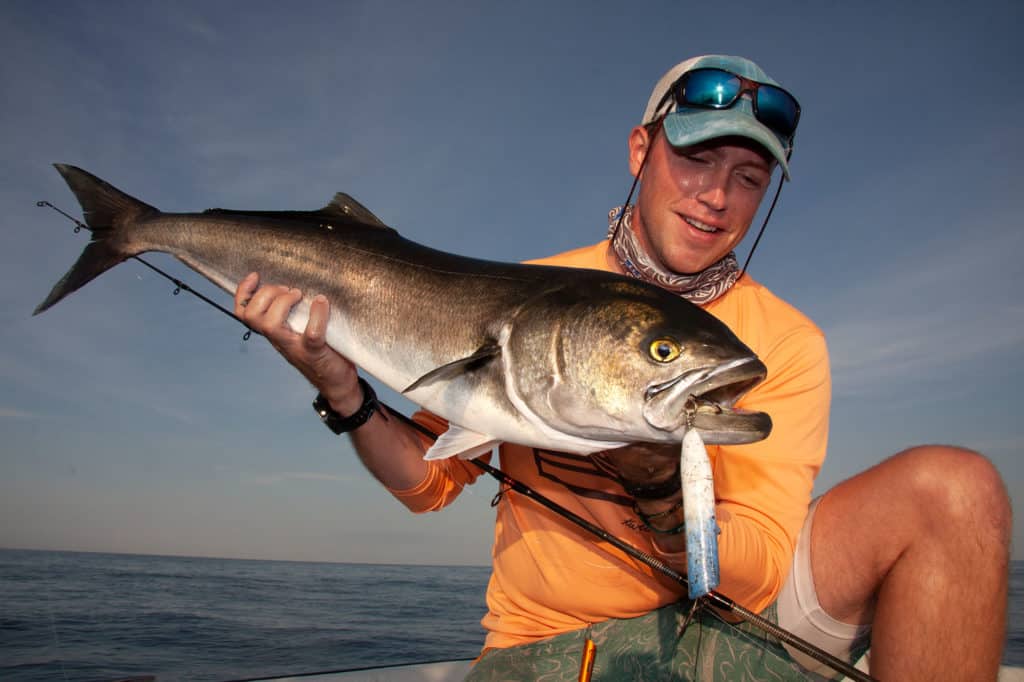
Giant bluefish appeared regularly in the Race early last summer and stayed for several weeks. The trick was to be there at the right time. During certain tide stages, like the first two hours of the flood or ebb, these monsters of 12 to 18 pounds would trap baitfish against the surface, their presence revealed by clusters of working birds and surface breaks. On calm days—the only sensible time to fish the turbulent Race—these blues made for world-class topwater action for anglers from three surrounding states (Connecticut, New York and Rhode Island). With the gators in such feed-mode, any 5- to 7-inch surface plug or 2- to 3-ounce metal lure like a Kastmaster or Deadly Dick was foolproof.
Fishing the Race on windless days is straightforward for anyone in a seaworthy (18 feet or longer) boat. Time your trip to arrive about a half hour after the slack tide when the current begins to move. Locate the small vessel fleet or cluster of birds, and run uptide of the action. Cut the motor and drift back toward the rip line, blindcasting or targeting specific breaks as you drift.
Spinning rods for the Race must withstand punishment because you might need to pull a big fish from the rip itself. According to Randy Chin, CEO of Temple Reef rods, an ideal rod is a 7-footer with a medium-slow taper and medium action such as the Vortex V2. “Rods for this application shouldn’t be too long,” says Chin, “a 7- to 7-foot-3-inch is optimal because an 8-footer will feel hefty. A compact rod will give better balance, control and casting accuracy from a boat. The Vortex V2 weighs only about 7 ounces and is designed for rough and tough. For casting rods we always emphasize weight—the accuracy and reaction you can achieve with a lightweight setup is paramount—sometimes there’s only that split-second that determines a hookup or a miss.”
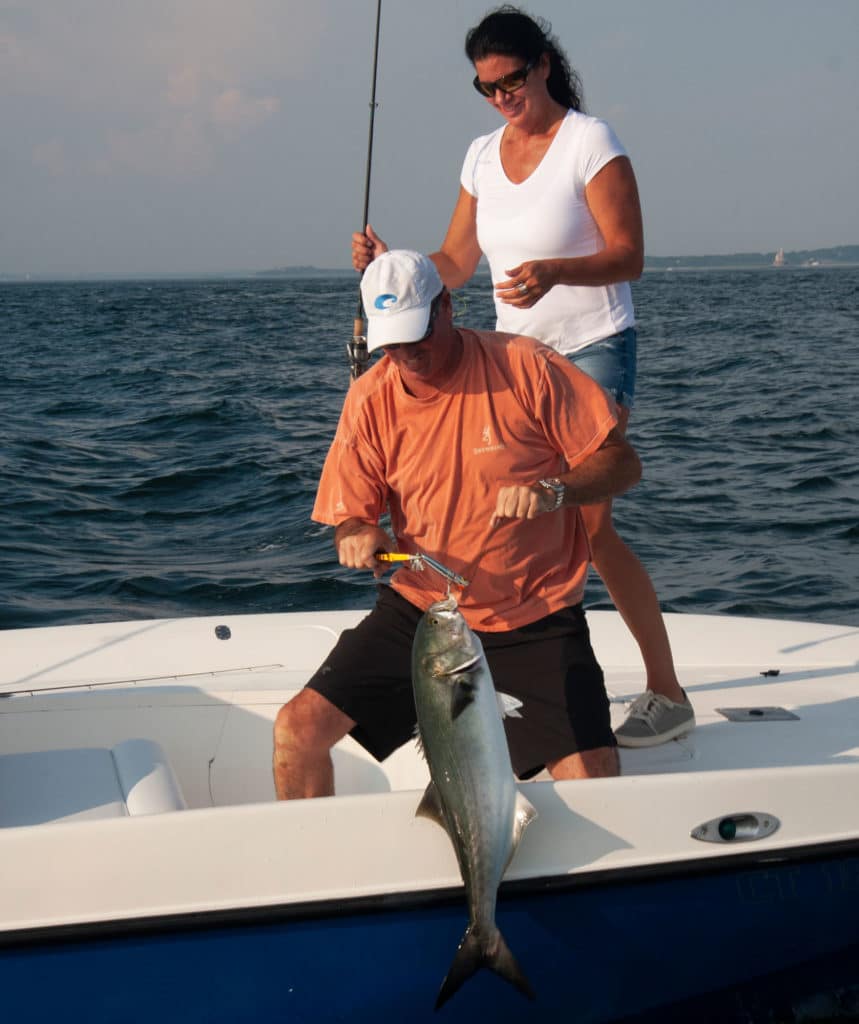
Taylor and I spent our last two hours of daylight in the lower Connecticut River tracking and casting to tormented bunker schools, the action only ending after sunset in the then ink-black water. We each boated four fish between 12 and 17 pounds, all carefully released except the smallest one, which was headed for the smoker.
Feeling Blue
In 1986, recreational anglers caught a record 151.5 million pounds of bluefish on the East Coast. By 2018, recreational fishing harvested just 13.5 million pounds. The complicated reasons for this decline include cyclical population swings, overfishing, climate change, and changing migration patterns.
“Although the stock is down,” says Justin Davis, assistant director of the fisheries division for the Connecticut Department of Energy & Environmental Protection, “the decline seems to be pronounced in nearshore waters. It’s not a bait shortage, and warming water doesn’t make sense as an explanation—bluefish like warm water.”
In 2019, scientists saw a promising uptick in small bluefish abundance in the Long Island Sound. They’ve also heard reports from fishermen who have seen large groups of enormous bluefish offshore in recent years. “But we can’t just assume most of the bluefish have moved offshore—we need to implement more conservation management,” he says.
Read Next: Back-Bay Bluefish Action in New York
The Atlantic States Marine Fisheries Commission, which cooperatively manages bluefish throughout its East Coast range, announced a 25 percent catch-limit reduction this year in conjunction with the Mid-Atlantic Fishery Management Council. The commission and council continue to work on a rebuilding plan.
In the meantime, the daily bag limit on bluefish in Connecticut has dropped from 10 to three fish this year, a change that also occurred in neighboring Rhode Island and New York.
About the Author: Author of Fishing Long Island Sound — A Guide for Beach and Boat Anglers and Fishing Diamond Jigs and Bucktails, Capt. Tom Migdalski is a freelance outdoor writer and photographer specializing in Northeast/New England saltwater fishing. He is the Director of Club Sports, Undergrad Intramurals and Outdoor Education at Yale University. Tom lives in East Lyme, Connecticut with his wife Carol.

